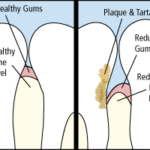Gum Disease

What is Gum Disease?

Gum disease, also known as periodontal disease, is an infection of the gums that surround your teeth. It is one of the primary causes of tooth loss in adults. Because it is virtually pain-free, many patients do not realize they have the disease. During each regular checkup, we will check for signs of periodontal disease by measuring the space between your teeth and gums.
What causes gum disease?
Certain factors can increase a patient’s risk of developing periodontal disease, including:
- Smoking or using chewing tobacco
- Diabetes
- Certain types of medication such as steroids, anti-epilepsy drugs, cancer therapy drugs, calcium channel blockers, and oral contraceptives
- Bridges that no longer fit properly
- Crooked teeth
- Old fillings
- Pregnancy
Symptoms of Periodontal Disease
While it is possible to have periodontal disease and not know it, some symptoms can include:
- Gums that bleed easily
- Red, swollen, tender gums
- Gums that have pulled away from the teeth
- Persistent bad breath or unpleasant taste in the mouth
- Pus between your teeth and gums
- Loose or separating permanent teeth
- Any change in the way your teeth fit together when you bite
- Any change in the fit of partial dentures
Stages of Gum Disease
Gum disease is caused by a buildup of plaque, a sticky form of bacteria that forms on the teeth. If the plaque is not removed by flossing, brushing, and regular dental checkups, it will continue to build up and create toxins that can damage the gums.
Periodontal disease forms just below the gum line and creates small pockets that separate the gums from the teeth. It has two stages: gingivitis and periodontitis.
- Gingivitis — This is the early stage of gum disease, when the gums become red and swollen, and bleed easily. At this stage, the disease is treatable and can usually be eliminated by daily brushing and flossing.
- Periodontitis — If left untreated, gingivitis will advance into periodontitis. The gums and bone that support the teeth will become seriously and irreversibly damaged. Gums infected with periodontitis can cause teeth to become loose, fall out, or require removal by a dentist.
Gum Disease Treatments
If you’ve been diagnosed with gum disease, there are a variety of treatment options, depending on the details of your situation and the severity of the problem. We always start with the least invasive options, which are non-surgical. However, in more serious cases, surgery may be necessary.
Non-Surgical Gum Disease Treatment
The first line of defense against gum disease is a unique type of cleaning called “scaling and root planing.†In this procedure, an ultrasonic cleaning device is used to remove plaque and tartar from your teeth where regular cleaning devices can’t reach: under the gum line, on the tooth, and around the root.
Then the rough surface of the tooth and the root are smoothed out (planed). This provides a healthy, clean surface that makes it easier for the gum tissue to reattach to the tooth.
If you address your gum disease before it becomes severe, scaling and root planing may be the only treatment you need. However, as with any dental procedure, after-care is vital. In order to keep your teeth in good shape and resist future occurrences of gum disease, you must brush and floss daily, eat a healthy diet, avoid tobacco use, and have regular dental checkups.
Even after a successful scaling and root planing, if you don’t attend to your teeth properly, it’s quite likely that you’ll develop gum disease again.
Surgical Gum Disease Treatments
If the tissue or bone surrounding your teeth is too damaged to be repaired with non-surgical treatment, several surgical procedures are available to prevent severe damage and to restore a healthy smile. We will recommend the procedure that is best suited to the condition of your teeth and gums.
The following is a list of common types of periodontal surgery:
- Pocket Depth Reduction: In a healthy mouth, the teeth are firmly surrounded by gum tissue and securely supported by the bones of the jaw. Periodontal disease damages these tissues and bones, which leaves open spaces around the teeth that we call pockets. The larger these pockets are, the easier it is for bacteria to collect inside them, which leads to more and more damage over time. Eventually the supportive structure degrades to the point that the tooth either falls out or needs to be removed.During pocket reduction procedures (also known as “flap surgeryâ€), we fold back the gum tissue and remove the bacteria hiding underneath, as well as the hardened plaque and tartar that have collected. We may also remove any tissue that is too damaged to survive. We then sew the healthy tissue back into place. Now that the tooth and root are free of bacteria, plaque, and tartar, and the pockets have been reduced, the gums can reattach to the teeth.
- Regeneration:Â When the bone and tissue supporting the teeth have been lost due to severe gum disease, we can restore these areas with a regeneration procedure. During this process, we begin by folding back the gum tissue and removing the bacteria, plaque, and tartar. Depending on your situation, we may then perform a bone graft to stimulate new bone growth, or we may apply a special kind of protein that stimulates tissue growth to repair the areas that have been destroyed by the disease.
- Soft-Tissue Graft:Â A frequent symptom of gum disease is gum recession (also called gingival recession). As the gums recede, more of the roots are revealed. This can make teeth appear longer and can also create sensitivity to hot or cold liquids or food. It also exposes the tooth to increased damage from gum disease, as bacteria, plaque, and tartar attack the surface and root of the tooth.During a soft-tissue graft, tissue from the top of your mouth or another source is sewed to the gum area, to cover the roots and restore the gum line to its original, healthy location. This procedure can also be performed for cosmetic purposes.
How To Prevent Periodontal Disease
Regular dental checkups and periodontal examinations are vital for maintaining your health and the health of your smile. You don’t have to lose teeth to periodontal disease. By practicing good oral hygiene at home, you can significantly reduce your chances of ever getting it.
Remember to brush regularly, clean between your teeth, eat a balanced diet, and schedule regular dental visits to help keep your smile healthy.
Schedule a Consultation
If you are interested in learning more about Gum Disease and Periodontal Disease, contact our office at 617-965-7673 to schedule a consultation today.

